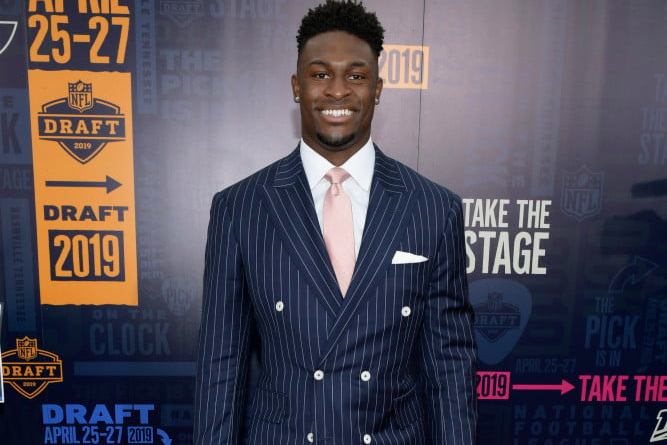Why does James Bond always look so good when he struts into the room? It’s not the martini in one hand. It’s not the Walther PPK in the other hand. And it’s not the winning smile, though that helps.

It’s the suit. A man wearing a suit with a perfect fit is a man looking as close to perfect as he can.
With a great suit comes confidence, poise, and added respect, both from those you meet and from the man in the mirror. But even the finest suits out there are no good if they don’t fit you well — in fact, you’d look better in a $100 suit from Target that happened to fit you perfectly than you would in an $8,800 handmade silk suit from Joe Bananas on Madison Avenue that fit you terribly. You’d look best in one of those that fit perfectly, for the record.
If you want to get the best suit for your body, you need to go to an expert tailor. If that’s not in the cards right now, then take some expert advice before you go out looking for your next pair of coat and trousers. We talked to was Scott Wicken, content director at menswear brand Combatant Gentlemen.
Wicken’s first major piece of advice?
Be Real About Your Body
“You need to be realistic about your body type,” Wicken explains. “The guy wearing a properly fitting suit that matches his body type is going to look a whole hell of a lot better than the guy trying to squeeze into something that’s not right for him. The reverse is true as well; feeling weird about wearing stuff that’s ‘too tight’ and overcompensating with a baggy fit is only going to have a disastrous effect on how you look.”
If You’re Big and Tall
Wicken says bigger guys should “opt for a suit with a proper amount of room in the chest and shoulders to accommodate your frame and make sure the stomach area is fitted but not tight. If you’re on the tall side, just make sure you’ve got the right length in your jacket and sleeves. Something too short or long is only going to enhance your height, and not in a good way.”

He adds that “finding a fit that works for the big and tall guy is about paying extra attention to the details and finding a suit cut that isn’t oversized, baggy, and too long. It might take some getting used to, but you still want things to fit properly. That is to say, trim but not tight, even on a broader frame or if you’ve got a belly. Avoid slim or narrow lapels, [as] they’ll look out of proportion with your size, and make sure your pants strike the right balance in fit. Don’t overlook the right hem either; an overly long pant hem is only going to make the pants look baggier, and therefore, sloppy.”
If You’re Muscular and Athletic
Wicken breaks it down: “Chances are, you’re broader up top with defined shoulders and a narrower waist, and that desirable V-shape you’ve got can be a tough fit when it comes to finding a suit. Often that standard suit set with a 10-or 8-inch drop between the jacket size and pants size isn’t going to work for you. Ideally, you want to look for suits that are sold as separates, meaning you can purchase the jacket size separately from the pant size, ensuring the right sizing. Fit-wise, you want to make sure you’ve got enough room where you need it but not too much that it looks like you’re wearing the wrong size. Depending on your size, a slim cut suit will work (just make sure it’s not too tight) or you can look for suiting that maintains a slim cut but has adjustments, like a slightly lower armhole and increased room in the chest to accommodate your frame. Lapel-wise, a medium to wide-width lapel is going to accentuate your V-shape and a nipped-in jacket waist is going to fit you properly without having to tailor excessively.”

“Jacket-wise, make sure you have enough room in the chest and shoulders and avoid extreme tightness in the bicep and popping of the lapel out from your chest (this indicates a jacket that is too small). You want to maintain the slim cut proportions with the pants and make sure the taper isn’t too tight; looking top-heavy is never a good thing.”
If You’re Slender
“As always, you want the right balance, slim but not tight,” Scott says. “Look for a slim cut (obviously) that features higher armholes and narrow proportions. Many slim guys still buy their suits too large so try going down a suit size by one, you might be surprised. Unless you’re popping out in all the wrong places, going down a size could give you a better-proportioned fit. Slim cut suits often have equally narrow lapels, which work well, but you could also opt for a peak or wider lapel if you want to give your shoulders a bit of heft and broadness. Below the waist, you’ll want the pants trim and with a nice taper, any billowing is only going to accentuate your slimness.”

He elaborates: “Tight is never a good look, nor is it going to look right for a professional setting, regardless of how thin you may be. Alternatively, you want a trim fit — a baggy or billowy suit isn’t going to add heft or bulk, it’s only going to look baggy and draw attention to your thin frame. [Bigger guys should] skip the three-piece or vest addition, as it’s only going to add extra bulk to your substantial frame, [but] for thinner guys, you’ve got more freedom here, so try that three-piece option and go with a slimmer tie. But not too slim.”
Don’t Forget the Pants
Too often, men get hung up finding the perfect suit jacket and treat the pants like they’re not 50% of the ensemble. “No matter what your body type or size is, an overall proper fit and proper tailoring, so jacket cuffs, pant hems, pant waist, and seat are always key,” Scott says.
Go Easy on Accessories
Once you have the perfect suit, don’t gild that lily. “Don’t go overboard with suiting accessories; keep it to one or two max,” Scott advises. “Over-accessorizing with tie bars, lapel pins, and pocket squares is a common mistake I see guys make, [but] simple is better. And keep the bowties to the tuxedos only.”



